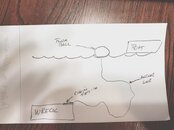The SMB is reeled in to be a shorter length of line than the Tie in. This way even if the boat does an almost 360 sweep, the smb line is on the inside circle and the tie in line is on an outside path circle. The 2 paths never cross until the boat has done a RARE 2 full 360 rotations.
Since you are using a chain it can't be loosened against the weight of the 32 ton boat unless the captain moves the boat over the wreck to take the strain off.
It's dangerous to start the engines with divers still on the tie in line doing stops in order to loosen the strain. That means a diver has to wait until everyone is back on board and checked off the manifest. Then another or same tie-in diver has to Re-Drop to go untie at 130 feet. That's a hellava dangerous bounce dive and great way to get bent because you are using a chain that won't loosen.
In our case we splash with ~20 ft of rope coiled in our one hand. Swim the bare rope down to the wreck and do 3 wraps around a known ballord/machinery/etc (never a railing,they break). This is your strain tie in. Then move over a couple of feet and tie in your primary slip knot tie in and followed by your secondary tie in slip knot.
The last diver on the wreck does the un-tie and also does not begin his dive until the customers are half way or more thru their estimated dive time. He usually passes several of them on stops going down the line himself. At the end of his dive time, he yanks the double slip knot tie ins and lets the strain tie feed thru and sets the boat free. Then goes over and grabs the SMB reel and does a normal ascent.
20 feet of Frayed end rope that has to be cut off from chaffing is just part of the cost of doing business. If the authorities will let the captain, many of us have used a sunken beer keg pulled down by the boat 20 feet under the surface to be made an underwater hidden mooring bouy for the whole dive season. It works great and rec boats never see it. The divemaster just has a quick splash to both tie in and un tie and kegs are CHEAP and last longer than the rope. They float great upside down and pumped since the handles will be facing down to the wreck when tied off. A small ring or loop is the attachment point for the boat line. End of the season, cut the rope, retrieve the keg.
With a drop chain & ball, Someone has do a bounce dive to get the chain loose. And if it's the same installing diver, he's already got bubbles in his tissues no matter what green color his computer says. Doing a 130 bounce dive to retrieve/free the boat is just asking for a chamber ride. Sinking a keg is easy and cheap by pulling it down with boat backing up.





